
by Carrie Stevenson | Apr 30, 2020
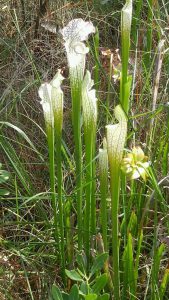
White-topped pitcher plants in bloom at Tarkiln State Preserve. Photo credit: Carrie Stevenson, UF IFAS Extension
If you live in northwest Florida or southeast Alabama and have never laid eyes on our wild native carnivorous plants, it is about time! April and early May are the best time to see them in bloom. We have six species of pitcher plants (Sarracenia), the most common being the white-topped (Sarracenia leucophylla). However, they come in multiple colors, from yellow and red to a deep purple, and in different sizes.
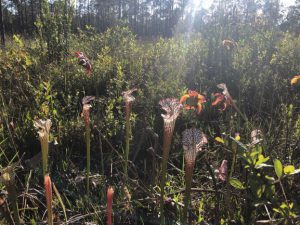
Pitcher plants and their pinwheel-shaped flowers at Splinter Hill Bog. Photo credit: Carrie Stevenson, UF IFAS Extension
One thing they have in common, though—they eat meat. Carnivorous plants all over the world have evolved in places that left them few other options for survival. These plants are typically found in extremely wet, acidic, mucky soils with very low nutrient levels. Normally, plants uptake nutrients like nitrogen and phosphorus from the soil around them. Not being available in these particular environments, carnivorous plants (or more specifically, insectivorous) developed a way to extract nutrients from insects.
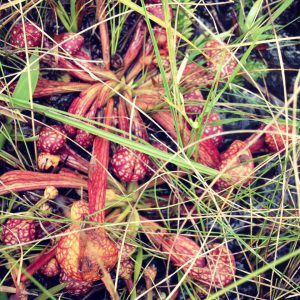
Small parrot pitcher plants lie on the ground instead of standing upright at Blackwater State Forest. Photo credit: Carrie Stevenson, UF IFAS Extension
So how does it work? Pitcher plants have a modified leaf, which instead of lying out flat like most plants, is rolled up into a tube, or “pitcher” shape. The inside of the pitcher has a sweet sap, and the walls of the tube are lined with tiny, downward-pointing hairs. Separate from the leaf, the plant has an elaborate flower structure, which attracts insects for pollination. While nearby, these insects are also attracted to the colorful leaf and the sweet sap in its pitcher. The insect will land on the lip of the leaf, then crawl down.
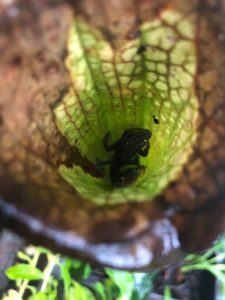 Those sticky, downward facing hairs are a trap, preventing insects from leaving the pitcher. Enzymes—a cocktail of proteins naturally found in many other plants but used creatively here—in the sap break down the bug bodies and convert them to nutrients for the plant. In fact, if you slice a cross-section into a pitcher wall or break open a dried one, you will see countless dried exoskeletons at the bottom of the tube. Several other enterprising species have taken advantage of the pitcher plant’s creative structure. More than once, I have seen tiny spiders spin webs across the mouth of the tube, or small lizards and frogs at the bottom, waiting patiently for prey.
Those sticky, downward facing hairs are a trap, preventing insects from leaving the pitcher. Enzymes—a cocktail of proteins naturally found in many other plants but used creatively here—in the sap break down the bug bodies and convert them to nutrients for the plant. In fact, if you slice a cross-section into a pitcher wall or break open a dried one, you will see countless dried exoskeletons at the bottom of the tube. Several other enterprising species have taken advantage of the pitcher plant’s creative structure. More than once, I have seen tiny spiders spin webs across the mouth of the tube, or small lizards and frogs at the bottom, waiting patiently for prey.
Some of the best places to see pitcher plants in the area—they also bloom in October—are Tarkiln Bayou State Preserve, Weeks Bay National Estuarine Research Reserve, Splinter Hill Bog Preserve, and Blackwater State Forest.

by Carrie Stevenson | Apr 24, 2020
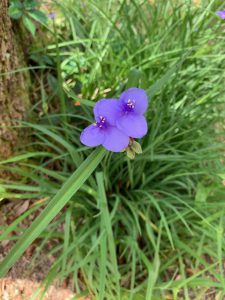
The brilliant purple, edible spiderwort flowers are only around for a day! Photo credit: Mary Anne Tomlinson
The spiderwort is a pretty little plant that most people have encountered in their yards or on roadsides. In cattle or hay pastures, it is considered a weed because cows won’t eat it, and its high moisture content can ruin hay harvests. In a home landscape, though, it can be a nice addition to the yard. I know many homeowners who refuse to let them be mowed down with the lawn simply because of their brilliant color. The native spiderwort (genus Tradescantia) is a perennial flower that grows in clusters, often in moist soils. It is a member of the dayflower family, which means each flower is only open for a single day. The plant, a favorite of bumblebees, can be identified quickly by its triad of violet petals and bright green, strap-like leaves.
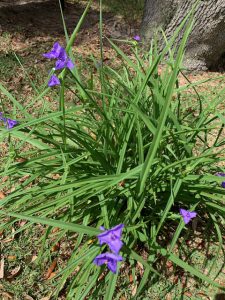
Spiderworts bloom in spring and grow in clumps of bright green, strappy leaves. Photo credit: Mary Anne Tomlinson
Known by common names as varied as “Bluejacket,” “Snotweed,” and “Cow Slobber” (due to the mucilaginous—mucus-like–consistency of its sap), the plant is widespread throughout the eastern and central United States. An interesting aspect of this sap is that it can be used as a salve for insect bites, similarly to aloe. Even more useful for those interested in native edible plants is that the flowers, stems, and leaves can be eaten raw in a salad or cooked and used as a culinary herb. The flowers can be candied with sugar as a dessert or used atop cakes.
Interestingly, the spiderwort can also indicate the presence of radiation. The bluish hairs on spiderwort flower stamens will turn pink in the presence of low levels of radiation, often more reliably than mechanical dosimeters.

by Carrie Stevenson | Jan 17, 2020
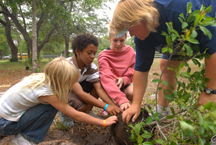
4H youth assist an IFAS Extension agent in planting a tree. UF/IFAS Photo: Josh Wickham.
This week, we celebrate Florida’s Arbor Day. “What?” you may say—“Isn’t Arbor Day in the spring?” Well, yes and no. National Arbor Day is celebrated in the spring (April 24 this year), usually within a day or two of Earth Day. However, because of the wide range of climatic environments throughout the United States, each state has its own date based on ideal growing conditions. As it stands, Florida’s is the 3rd Friday in January, as we are situated so very far south. Alabama and Georgia, where so many of us north Floridians experience similar weather, hold their Arbor Days in late February.
Contrary to popular opinion, the optimal planting time for trees in not in the spring, but in fall and winter. Planting during dormancy allows trees to focus their energy resources on growing healthy roots. In the coming spread, a steady supply of warmth, sunshine, and pollinators bring on leaf growth, flowers, and fruit.
Check with your local Extension offices, garden clubs, and municipalities to find out if there is an Arbor Day event near you! Several local agencies have joined forces to organize tree giveaway and sales events in observance of Florida’s Arbor Day.
Friday, January 17th
Okaloosa County: UF/IFAS Okaloosa County, in partnership with the Florida Forest Service, the Niceville Senior Center and the Kiwanis Club of Niceville-Valparaiso, will give away trees beginning at 9 a.m., until all trees are gone. Niceville Senior Center, 201 Campbell Drive. A UF/IFAS Extension agent will conduct a tree planting demonstration and UF/IFAS Master Gardener volunteers will be available to answer questions about planting and growing trees in North Florida.
Saturday, January 18th
Walton County Master Gardener Volunteer Tree and Plant Sale
A wide variety of plants and trees will be offered: shade trees, ornamentals, citrus, flowering, tropical, fruits, nuts, berries, shrubs, grasses, vines, palms, and ferns.
Time: 9 a.m. to noon
UF/IFAS Extension Walton County
DeFuniak Springs, FL
Escambia County: UF/IFAS Extension Escambia County is partnering with the Escambia County Water Quality and Land Management Department and the Florida Forest Service for the annual Tree Giveaway. Events begin with a tree planting demonstration at 8:45 and conclude by noon (or until the trees are all distributed, two per household). Beulah Middle School, 6001 Nine Mile Road, Pensacola.
Jackson County: Tree give-away Saturday, January 18 at 9 am at Florida Forest Service work center at 3973 Kynesville Rd, Marianna
Wakulla County: UF/IFAS Wakulla County Master Gardeners are hosting a tree giveaway.
Saturday, January 25th
Leon County: UF/IFAS Extension Leon County Master Gardeners will assist with the county’s Arbor Day tree planting at 9 a.m. Martha Wellman Park, 5317 W. Tennessee St., Tallahassee.
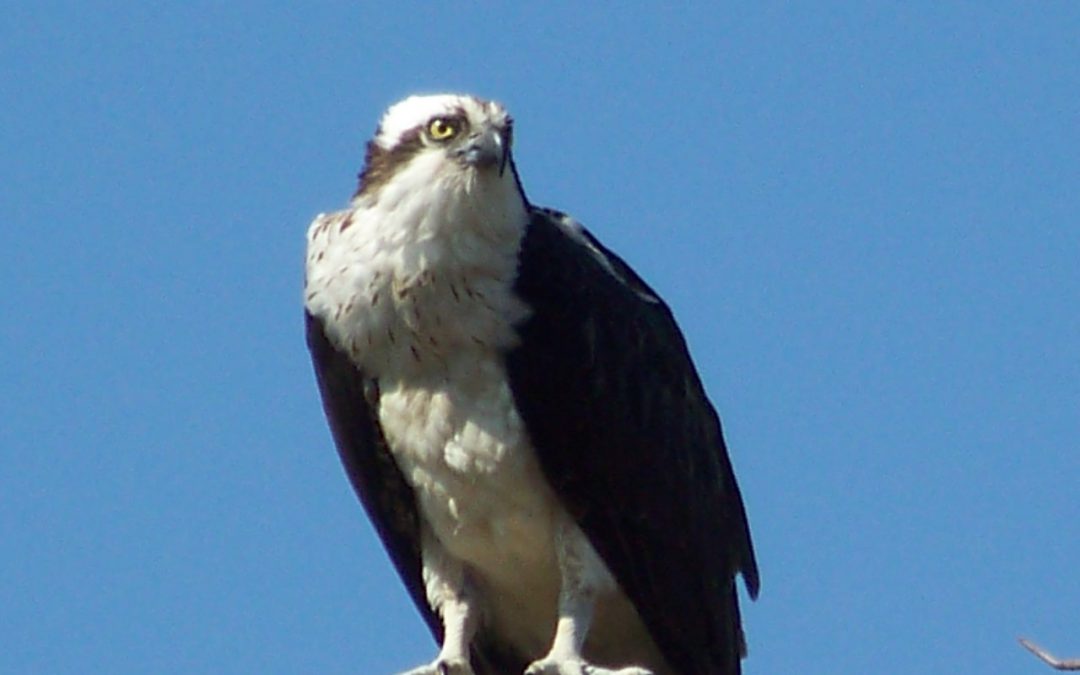
by Carrie Stevenson | Sep 27, 2019
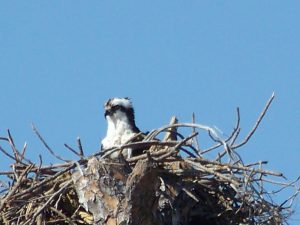
Ospreys, or fish hawks, build their nests from sticks atop dead trees. Photo credit: UF IFAS Extension
Big hurricanes like Dorian (Bahamas) and 2018’s Michael (central Florida Panhandle) were devastating to the communities they landed in. Flooding, wind, rain, loss of power and communications eventually made way for ad hoc clearing and cleanup, temporary shelters, and a slow walk to recovery. Among the most striking visual impacts of a hurricane are the tree losses, as there are unnatural openings in the canopy and light suddenly shines on areas that had been shaded for years. In northwest Florida, pines are particularly vulnerable. After any hurricane in the Panhandle, you can drive down Interstate 10 for miles and see endless pines blown to the ground or broken off at the top. During Hurricane Ivan 15 years ago, the coastal areas in Escambia and Santa Rosa lost thousands of trees not only due to wind, but also to tree roots inundated by saltwater for long periods.

Dead trees left by hurricanes serve as ideal nesting ground for large birds like ospreys. Photo credit: Carrie Stevenson, UF IFAS Extension
Nature always finds a way, though. Because of all those dead (but still-standing) pines, our osprey (Pandion haliaetus) population is in great shape in the Pensacola area. How are these two things related? Well, ospreys build large stick nests in the tall branches/crooks of dead trees, known as snags. They particularly prefer those near the water bodies where they fish. When I first moved here 20 years ago, I rarely saw ospreys. Now, it’s uncommon not to see them near the bayous and bays, or to hear their high-pitched calls as they swoop and dive for fish.
If you are not familiar with ospreys, they can be distinguished by their call and their size (up to six foot wingspan). It is common to see them in their large nests atop those snags, flying, or diving for fish. I usually see them with mullet in their talons, although they also prey on catfish, spotted trout, and other smaller species. They have white underbellies, brown backs, and are smaller than eagles but larger than your average hawk. One of their more interesting physical adaptations (and identifying characteristics) is their ability to grip fish parallel to their bodies, making it more aerodynamic than the perpendicular method most birds use.
Ospreys mate for life, and cooperate to build nests and care for young. The species has overcome many complex threats—including DDT damage to eggs and habitat loss—but the sight of them flying is always inspiring to me. They are a living embodiment of resilience amidst adversity.
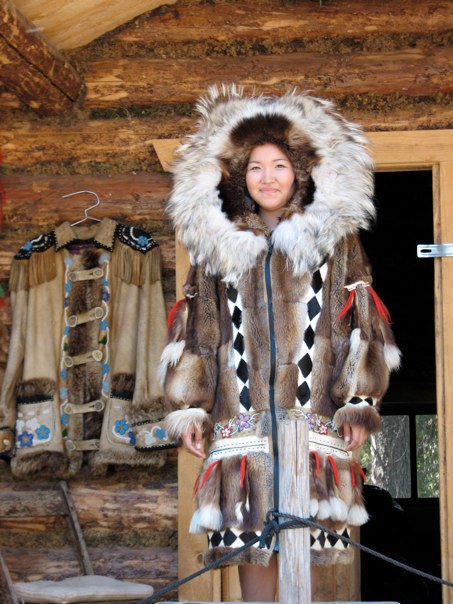
by Carrie Stevenson | Aug 16, 2019

The indigenous people of Alaska have long adapted to freezing winters by relying on local wildlife for warm clothing. Photo credit: Carrie Stevenson, UF IFAS Extension
Human beings are an incredibly adaptable species. For countless generations, our ancestors have migrated to the far reaches of the planet to find food and territory. The Inuit people of Alaska adapted to months of freezing weather and darkness by developing techniques for harvesting fish through the ice and making furs from local wildlife. Meanwhile in the remote Andaman Islands, tribal people still subsist on fruit from the prolific rain forest and spearfishing in the Bay of Bengal.
Wildlife have behaved similarly throughout history. Before much of the United States was developed and crisscrossed with roads, large herds of bison grazed the entire mid and mountain west. Until the mid 1960’s, the upper Midwest and east coast experienced a tree-based squirrel migration of millions. Overhunting also impacted both of these species. According to the National Wildlife Foundation, monarch butterflies migrating for the winter from the United States to Mexico were down 15% last year due to hurricanes, warmer fall temperatures, and a lack of food sources along their routes. Overall, monarch numbers are down 90% from a peak population 20 years ago.

Worldwide, mangrove trees are moving from warmer climates into temperate habitats as climate changes. Photo credit: Carrie Stevenson, UF IFAS Extension
Recent changes in climate are also becoming a factor for human and wildlife behavior. I find myself “migrating” into the air conditioning more often in these dog days of August as 110°+ heat indices bear down. The European heat wave this summer resulted in record-breaking temperatures and at least 8 deaths. Many European countries have never needed air conditioning, so homes, public transportation, and vehicles provide no relief from the sweltering heat. Wildlife, by contrast, cannot move indoors. As the planet warms, some wildlife living in temperate regions may move because their homelands slowly turn subtropical. When this happens, history shows us that humans either “persecute, protect, or ignore” new species, which may result in great success or the downfall of species seeking new habitat. In addition, biologists have been observing and expecting many tropical species of plants and animals to expand into new, warmer territories, as formerly cold climates heat up and become more suitable for particular species to thrive. Mangroves, for example, are migrating beyond the equator worldwide, while the National Oceanic and Atmospheric Administration (NOAA) Arctic report card has shown that the melting of polar ice caps has literally broken up polar bear habitat, along with reducing populations of grazing herds of caribou and reindeer.
Keep in mind that neither one hot summer nor one cold winter define the pace of climate change. The issue at hand is the long-term change. We find ourselves, in August 2019, having just experienced the hottest July (globally) on record since worldwide recordkeeping began in 1880. Some may see this as a fluke, until we consider that NOAA and NASA data show that 17 of the 18 warmest years have occurred since 2001. The patterns are changing—and as always, we humans must adapt. It is important that our adaptation includes mitigation measures, which can range from reducing energy use to planting more trees. To learn more about changes in worldwide climate and what you can do to make a difference, visit the NOAA site https://www.climate.gov/




 Those sticky, downward facing hairs are a trap, preventing insects from leaving the pitcher. Enzymes—a cocktail of proteins naturally found in many other plants but used creatively here—in the sap break down the bug bodies and convert them to nutrients for the plant. In fact, if you slice a cross-section into a pitcher wall or break open a dried one, you will see countless dried exoskeletons at the bottom of the tube. Several other enterprising species have taken advantage of the pitcher plant’s creative structure. More than once, I have seen tiny spiders spin webs across the mouth of the tube, or small lizards and frogs at the bottom, waiting patiently for prey.
Those sticky, downward facing hairs are a trap, preventing insects from leaving the pitcher. Enzymes—a cocktail of proteins naturally found in many other plants but used creatively here—in the sap break down the bug bodies and convert them to nutrients for the plant. In fact, if you slice a cross-section into a pitcher wall or break open a dried one, you will see countless dried exoskeletons at the bottom of the tube. Several other enterprising species have taken advantage of the pitcher plant’s creative structure. More than once, I have seen tiny spiders spin webs across the mouth of the tube, or small lizards and frogs at the bottom, waiting patiently for prey.










